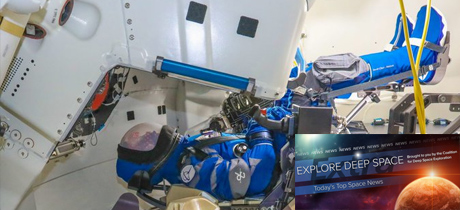In Today’s Deep Space Extra… Northrop Grumman’s Cygnus resupply mission set to depart the International Space Station on Tuesday with the next resupply mission, NG-16, scheduled for NET August 10. The second iROSA is now installed on the Space Station.
Human Space Exploration
ULA, Boeing, and NASA prepare for uncrewed and crewed Starliner flight tests
Coalition Members in the News – Boeing, United Launch Alliance
NASAspaceflight.com (6/26): At NASA’s Kennedy Space Center (KSC) and the Cape Canaveral Space Force Station, Florida, the spacecraft hardware and launch vehicles for two NASA Commercial Crew Program and Boeing test flights are coming together. Orbital Flight Test-2 (OFT-2) is set to launch Boeing’s CST-100 Starliner on July 30 for an uncrewed mission to deliver and return cargo from the International Space Station (ISS). With success, OFT-2 will set the stage for Starliner’s Crew Flight Test (CFT), a flight of the Boeing capsule with three NASA astronauts. Both missions will launch on ULA rockets.
Station crew readies for Tuesday Cygnus departure, NG-16 launch NET 10 August
Coalition Members in the News – Boeing, NanoRacks, Northrop Grumman
AmericaSpace.com (6/27): Launched in late February, Northrop Grumman’s 15th Cygnus resupply mission, named in honor of the late African American NASA mathematician Katherine Johnson, is scheduled to depart the International Space Station (ISS) on Tuesday at 12 p.m. EDT. Following departure, the NG-15 capsule will support the release of multiple CubeSats via NanoRacks and SlingShot deployment mechanisms, prior to deorbit. The next Cygnus resupply mission launch is planned for no earlier than August 10 from NASA’s Wallops Island Space Flight Facility.
Kimbrough, Pesquet wrap up solar array upgrades with third iROSA spacewalk
Coalition Member in the News – Boeing
AmericaSpace.com (6/25): Astronaut Thomas Pesquet and Shane Kimbrough finished their third spacewalk in nine days on Friday, completing the installation of the first two of an eventual six Roll Out Solar Arrays (iROSAs) on the solar power truss of the International Space Station (ISS). The astronauts upgraded the oldest of the ISS’s solar power modules on the far port side of the truss.
Report backs NASA proposal to change astronaut radiation exposure limits
SpaceNews.com (6/25): NASA plans to change the way it limits astronaut exposure to solar and cosmic radiation. Currently, lifetime exposure limits range from 180 millisieverts for a 30-year-old woman to 700 millisieverts for a 60-year-old man. NASA proposed changing that to a limit of about 600 millisieverts regardless of age or gender. A National Academies committee endorsed NASA’s proposal to change the radiation exposure limits but said the revised limit is still insufficient for crewed missions to Mars.
Other News
A satellite’s impending fiery demise shows how important it is to keep space clean
Coalition Member in the News – Boeing
Los Angeles Times (6/27): Launched in November, the small sats Alchemy and Augury are part of an experiment by Millennium Space Systems, a division of Boeing, to assess a drag technology intended to help prevent further accumulation of space debris in orbit around the Earth. Alchemy will test a strategy that will take satellites out of orbit after they complete their missions rather than continue to orbit and perhaps collide with another object and create more debris. Augury will serve as a control continuing to orbit to assess the effectiveness of the strategy.
NASA team to study new roles for the agency in addressing orbital debris
SpaceNews.com (6/27): NASA has assembled a working group to plan how the agency can become a more effective leader in addressing orbital debris concerns beyond those of NASA itself. Bhavya Lal, senior adviser to the NASA administrator for budget and finance, leads the effort. During the Secure World Foundation’s Summit for Space Sustainability last week, Lal talked about the project but didn’t elaborate on its work beyond that it is an internal NASA effort and not an interagency one.
China’s super heavy rocket to construct space-based solar power station
SpaceNews.com (6/28): China’s new super heavy Long March 9 rocket will be used to assemble solar power generating platforms in high Earth orbit, with a goal of gigawatt-level power generation by 2050. The solar power collection area would span square kilometers and include a large microwave power transmission sub-system, using microwaves or lasers. Long Lehao, chief designer of China’s Long March rocket series, spoke of the plan last week in Hong Kong.
Russia’s Soyuz launches Pion-NKS naval intelligence satellite
NASAspaceflight.com (6/25): On Friday, Russia launched the first in a new generation of ocean reconnaissance satellites, the Pion NKS, atop a Soyuz 2-1b from the Plesetsk Cosmodrome.
Major Space Related Activities for the Week
Major space related activities for the week of June 27 to July 3, 2021
Spacepolicyonline.co (6/27): NASA’s Astrophysics Advisory Committee meets virtually Tuesday and Wednesday. Topics will include the status of the Hubble Space Telescope, which experienced a computer difficulty on June 13 that remains under evaluation; launch of the James Webb Space Telescope (JWST) planned for later this year; and the Nancy Grace Roman Space Telescope. Wednesday is International Asteroid Day, which will be the focus of a NASA discussion at 1:00 p.m. EDT, broadcast on NASA TV and streamed on www.nasa.gov/nasalive. Russia’s next Progress resupply mission to the ISS is set to launch Tuesday at 7:27 p.m. EDT from the Baikonur Cosmodrome in Kazakhstan, with a docking planned for Thursday at 9:03 p.m. EDT.

